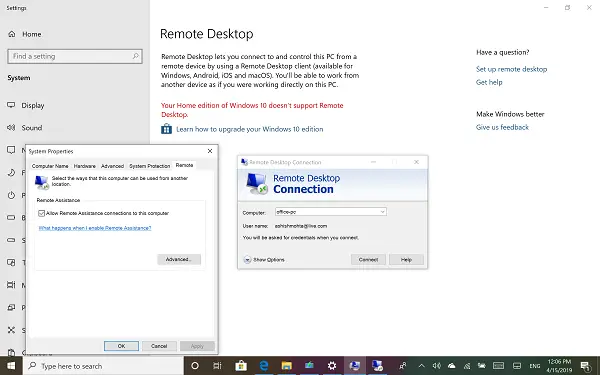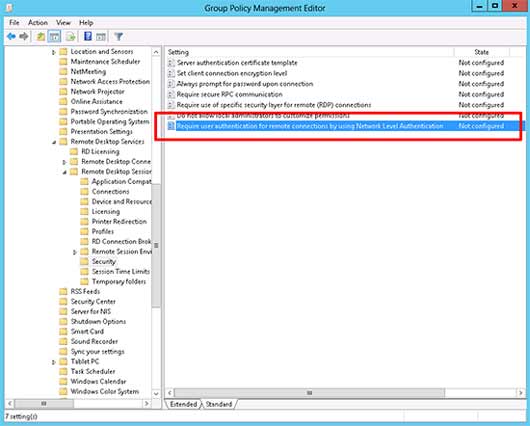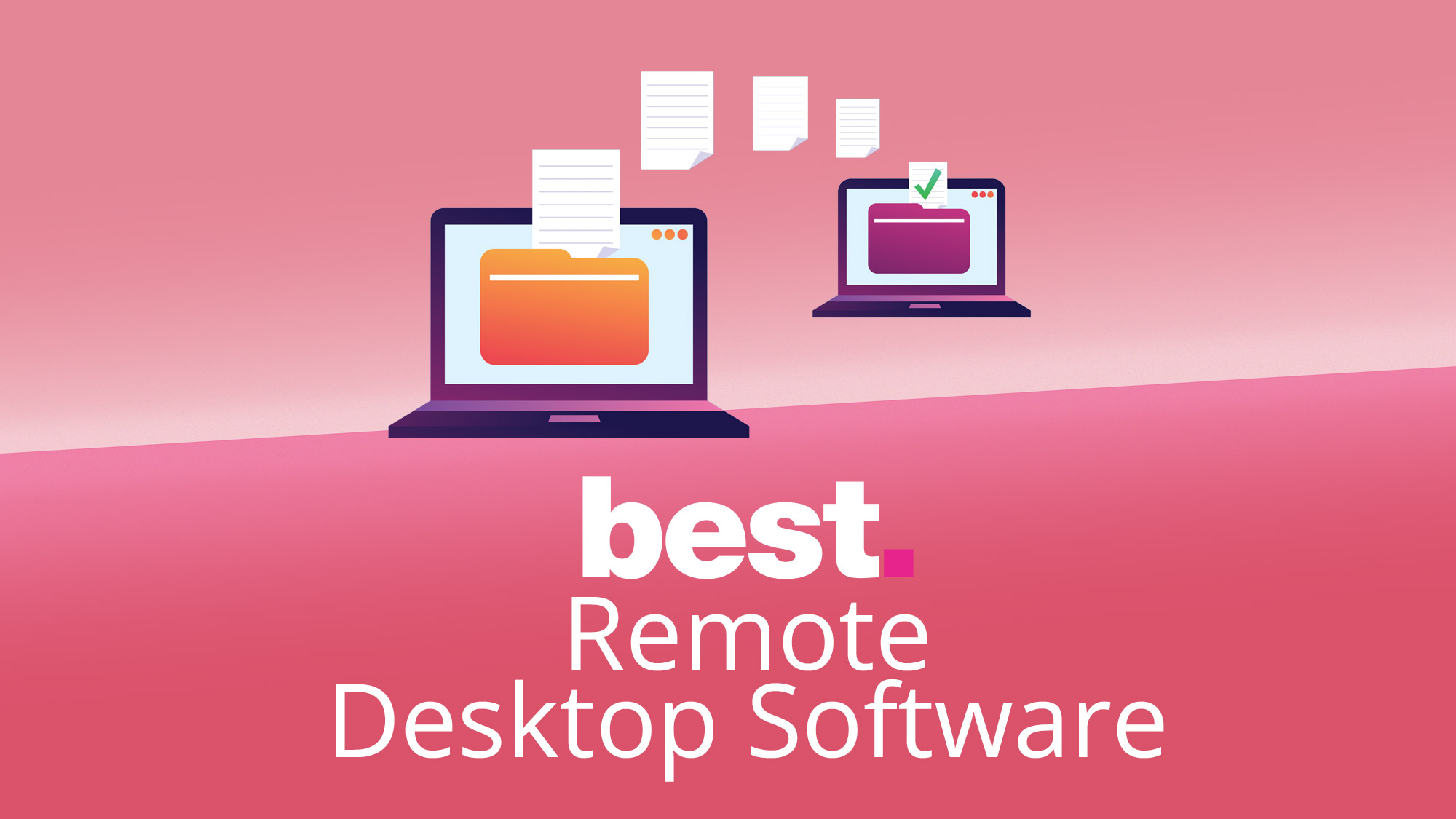- Remote Administration Tools Windows 10
- Remote Desktop Server Windows 10 Home
- Remote Desktop Server Windows 10 Home
- Enable Remote Desktop Server Windows 10
It’s quite easy to transfer files between computers on the network, all you have to do is select the folder to be shared and other users can find and connect to that folder and the files inside. If you use the Remote Desktop Connection feature in Windows you can even gain control of the remote computer, find your shared folder from it, and then transfer files between the two computers as required.
The new RDS Certificate will be when we connect to the server via Remote Desktop now Reference Links 1 Trusted Remote Desktop Services SSL Certs for Win10/2019. By default on a Windows Server Product Windows Remote Management (WinRM) is enabled, but Remote Desktop (RDP) is Disabled. On workstation operating systems neither is enabled by default, so if you want to be able to accomplish the following you will need to enable WinRM on the workstations.
Windows Remote Desktop actually has a feature built in that allows you to share any of the local drives on the host computer with the remote computer without having to manually share specific folders or drives. This is far easier and can be more secure because folders are not being shared permanently but only for the life of the Remote Desktop session.
Here we show you how to setup your Remote Desktop session to share some or all of your local drives.
1. You can start the Remote Desktop Connection from Start > All Programs > Accessories > Remote Desktop Connection or run Mstsc.exe from the Run dialog or Search box. The window will show the current connection in the computer box or you can select a previous session from the drop down.2. Click the Show options button at the bottom left.
3. This will display the connection preferences, click on the Local Resources tab. Look near the bottom in the section “Local devices and resources” and click the More button.
4. An entry called Drives will be in the list, if you tick that all drives will be mapped to the Remote Desktop and shared. If you only want to share specific drives which is safer, click the + to the left and expand the drives list, then you can specifically tick which drives that need to be shared, including ROM drives and USB flash drives the haven’t been inserted yet (Drives that I plug in later). Click OK when you’re done.
5. Upon trying to connect you will be asked if you trust the remote connection and clicking Show Details will show that it’s trying to share your drives. If you’re happy then tick the box to not be asked again and press Connect.
After a successful connection go to Computer or This PC on the remote computer and under Other you should see the shared drives. Now you can start transferring files to and from your remote computer
Another option for transferring files in the Remote Desktop session is by using the Windows Clipboard so you can right click and Copy the file on the host computer and then right click and select Paste inside the Remote Desktop. This works just the same as if you are copying and pasting inside your own computer and obviously also works on text.
The option to use the Clipboard should be enabled by default but you can turn it off and on from the Local Resources tab in step 3.
Fastest Way to Transfer Files to a Remote Desktop Computer
As there is a copy and paste function from the host machine to the Remote Desktop and the option to use the mapped drives to transfer files, which one is the quickest? If you add a standard shared folder which may already be set up between the computers, there are three ways to get the files transferred over the network to the remote machine.
As a simple test we decided to see which copy method was fastest to copy a selection of files and folders from one computer to the other using the three methods above. Here’s what we copied:
Copy Test 1: An ISO image 1.36GB in size
Copy Test 2: 3,427 files and 371 folders totalling 1.46GB of data
The test was run using a 10/100 network and both computers were running Windows 7.
Copy Test 1 (ISO Image) Min:sec
Copy and Paste (Host > RDC) 02:32
Mapped Drive From RDC 02:10
Standard Shared Folder 02:04
Copy Test 2 (Multiple Files) Min:sec
Copy and Paste (Host > RDC) 38:18
Mapped Drive From RDC 02:16
Standard Shared Folder 02:31
In test 1 you can see that the mapped drive and shared folder are quite close together, but copying from the host machine and then pasting into the Remote Desktop is around 20 seconds slower. It’s not much but would increase the larger the file used.
The results for test 2 aren’t a mistake as we ran it 2 or 3 times with the same outcome. To right click and copy from the host and paste into the Remote Desktop really did take nearly 40 minutes while the others completed in under 3. There is clearly a huge amount of overhead with copy and paste when using Remote Desktop and you should try not to use it for transferring more than a few files or a few dozen Megabytes at a time. Using one of the other methods will really help speed transfers up.
Remote Administration Tools Windows 10
You might also like:
 Change the Listening Port for Microsoft Remote Desktop Connection
Change the Listening Port for Microsoft Remote Desktop Connection 5 Tools to Scan Connected Computers on the Local Network and Find Shared FoldersRemotely Enable or Disable Windows Remote DesktopDisable Remote Desktop Auto Lock Screen on IdleConcurrent RDP Patcher Enables Remote Desktop in Windows 7 Home Premium
5 Tools to Scan Connected Computers on the Local Network and Find Shared FoldersRemotely Enable or Disable Windows Remote DesktopDisable Remote Desktop Auto Lock Screen on IdleConcurrent RDP Patcher Enables Remote Desktop in Windows 7 Home Premiumhow to pick excel file one pc to another pc
ReplyEveryone’s favorite and well-known way of transferring data, but usually RDP is not available through multiple NATs – when you have no dedicated external IP. In such cases, you need to use software with remote file transfer features such as AnyDesk or Igiko. They also have remote access features like RDP. I use Igiko, as it works via web browser.
ReplyThank you! This is really helpful.
ReplyI see you have many Thank Yous. Here’s one more: Thank you!
Replyit is really a perfect information.
Thanx for your Support
I logins for two secure networks. (NHS), as I work across both.
I need to transfer some of my files from one to another.
now because I am logged on to network and also logged on to remote network (via citrix) I do not have name for a specific computer as it is asking me to provide computer name.
Can you help me in order to transfer files from one remote network to local network? as steps above are for the personal to personal instead of one secure network to another? unless my limited knowledge of this is stopping me going any further?
I cross checked and found that all above options in my local as well as remote machine are already set (e.g. clipboard copy and other all ).
What extra I need to do that in Remote machine, open task manager and then stop remote desktop process running against my user name (with which I logged in to Remote desktop machine). Then log out from remote machine and re login. It started copying.
ReplyThank You a lot really helpful tip!
Replythankyouu very usefull!!
Replyeasy trick, helped a lot.. wasn’t able to find it so simple….. thanks…
ReplyThank you so much,really amazing post,it helped me out lot.
Replythank you.
ReplyThanks, it worked! Afterwards I realized though that you can just copy files on your local drive and paste them in the remote desktop…
Replyhey, it’s very useful tips.
 Reply
Replythank you, been searching for this info for quite a while, cheers
Replythank you.. it’s really useful for me..
ReplyThanks Raymond, you have helped me out a lot.
 Reply
ReplyVery useful tip! Thanks!
ReplyThanks for this post man, really helped me out
Erick
ReplyThanks for the help, it saved a lot of time :)
ReplyRemote Desktop Server Windows 10 Home
Nice and useful information – helped me as I was looking for exactly this feature. People like you are a great help! Cheers :-)
ReplyThanks for the info….help me a lot!
 Reply
ReplyThanks to this article it helps me a lot… cheers!
ReplyThank you Raymond :-)
ReplyThanks for this Raymond. Pretty useful information.
I have been looking into this for family members when they get problems or need files from me.
as always..you gave me another idea…thanks
Replygood one !
ReplyExactly what am looking for. Thanks Ray. Your Blog is still my home page for about a year.
ReplyVery nice tip Ray, thanks.
ReplyThanks Ray .. for this nice info…
keep posting… :)
Remote Desktop Server Windows 10 Home
ReplyEnable Remote Desktop Server Windows 10
Leave a Reply
Windows 10 can be configured to access your computer using Remote Desktop from a number of different devices. Allowing Remote Desktop sessions to your computer from your remote devices gives you access to files and resources from anywhere you are when away from home or the office.
To take advantage of RD, your host computer must be connected to the Internet, turned on and configured toallow connections from other devices. Access to the computer via Remote Desktop must be granted by permission and the connections allowed through the computer’s local firewall.
Why Use RD on Your Windows 10 Computer?
If you are physically sitting at your computer, then you do not need Remote Desktop. Accessing your computer with RD is a convenience which allows you to work on your computer from a remote location without taking your computer with you. However, there are a number of considerations in regard to using RD on your computer.
Security is of the utmost concern when using Remote Desktop so you need to be well aware of how you are configuring access to your computer. When RD is enabled a port is opened on the local network which makes your computer accessible with specific logon and permissions rights granted. Given the security concerns, it is important to understand that RD access can rights provide permission onto your computer with full administrative power as well as other user accounts from groups given access to the computer. It is important to use strong passwords when granting access rights to your computer over Remote Desktop.
Over a network or domain, Remote Desktop should be used in conjunction with the option for Network Level Authentication (NLA). Using NLA means that only accounts with specific Remote Desktop access within the network will be allowed to logon to computers via RD. If you are using Remote Desktop in a home environment, NLA should not be enabled.
Allowing Access in Windows 10 from Home
Enabling Remote Desktop means that you are allowing a direct connection to your computer which is a peer-to-peer connection. A wide range of devices can be used when making a connection with RD to your Windows 10 computer. There are two options for connecting to your computer using Remote Desktop, port forwarding and VPN (Virtual Private Network).
Port forwarding is a process which maps the public address of your router to the address of your computer on your network. In order to implement port forwarding from your router, you will need specific instructions from your router’s manufacturer.
Using VPN, you can connect to your computer with RDS as if it is part of the virtual private network. With this method you will not use a public IP address to connect to your computer, instead you will use the VPN to establish the secure connection. Once connected to the VPN, RD can then be used to connect to your computer. There are a number of different VPN services available which you can investigate based on your specific needs.
Remote Desktop Configuration on Your Computer
Accessing your computer at work may be controlled by security policies established on the network. Specific groups and users may be the only ones allowed to use RD so you should check with your IT support regarding what is allowed.
Configuring your PC for remote access requires just a few simple steps (Home editions do not include support for Remote Desktop):
- On the host device (the one you want to connect to), select Start and then click the Settings icon that looks like a gear.
- Select the System group icon and then the Remote Desktop item from the menu on the left.
- Use the slider switch to enable Remote Desktop. (To keep a PC awake and discoverable for connection availability you might consider turning off sleep/power-save modes.)
- Click Show settings to view and configure a list of other settings as necessary (most may not have direct relevance).
- As needed, click Select users that can remotely access this PC to add a specific user who will have access (members of the Administrators group automatically have access).
- Make note of the name of your PC under How to connect to this PC. You’ll need this to configure the client access.
Using the Windows Client
- If your remote computer or device does not have the Remote Desktop client already it can be downloaded with a quick search of the Microsoft Store.
- Add a computer connection to the RD client by choosing Add + and then Desktop.
- Enter the computer name and the account information which will be used to make the connection.
- Additional options are available by clicking on Show more. These options allow for specific configurations for the remote session, all of which can be saved for future use.
- You can also add remote resources such as Remoteapp programs, session-based desktops and virtual desktops which have been published in RDSH. Click Add + and then choose Remote resources from the Connection Center window to add these resources.
- Enter the feed URL already provided by an administrator and then click Find feeds.
- Enter the necessary credentials to subscribe to the feed.
To edit or remove a connection, click on the overflow menu (…) for the specific desktop and choose Edit or Remove as appropriate. To remove a remote resource, also click on the overflow menu (…) for the specific desktop and choose Remove. Specific connections can also be pinned to the Start menu by using the overflow menu (…) and clicking on Pin to Start.
Add a Remote Desktop Gateway
In order to connect to a host computer on the network from anywhere on the Internet you can set up a Remote Desktop Gateway:
- In the Connection Center click on Settings.
- At Gateway click on + to add the gateway (a gateway can also be added when adding a connection).
- Enter the server name which can be an IP address, computer name or Internet domain name (port numbers can be added as well using this format Name:443, where name is the computer name, domain or address).
- Enter the user account information or choose “Use desktop user account” to use the same account as that for RD connections.
- Save the configuration.
Conclusion
Remote Desktop is a convenient tool for accessing remote resources within a network or over the Internet. A Remote Desktop environment already setup on a network will provide users fast access to apps and resources important to them. Use from a home computer with the correct edition and configuration of firewall and network equipment is readily available and easy to achieve.
To learn more about Remove Desktop usage and implementation, contact our experts at RoyalDiscount.com – your online source for cheap OEM, Retail & Cloud products.
